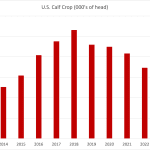By Phil Franz-Warkentin, Commodity News Service Canada
Winnipeg, May 16 (CNS Canada) – ICE Futures Canada canola contracts were weaker on Wednesday, taking some direction from Chicago Board of Trade soybeans and soyoil.
Strength in the Canadian dollar added to the weaker tone in canola, as the currency rallied back above 78 U.S. cents.
Bearish chart signals contributed to the declines as the July contract tested the 50-day moving average.
Forecasts are calling for at least a chance of rain across much of the Prairies over the next few days. However, more moisture will be needed, as conditions are getting very dry in many areas.
Read Also
Canadian Financial Close: Loonie weakens
By Glen Hallick Glacier Farm Media | MarketsFarm – The Canadian dollar pulled back on Monday, due to a lack…
About 14,316 canola contracts traded, which compares with Tuesday when 11,769 contracts changed hands. Spreading accounted for 7,224 of the contracts traded.
SOYBEAN futures were sharply lower on Wednesday, as uncertainty over trade relations between the United States and China weighed on values. Representatives of the two countries are meeting in Washington this week, but are rumoured to still be far apart on reaching a deal.
Good seeding weather across the Midwest and ideas that seeded soybean area may still end up above earlier estimates also weighed on values.
However, ongoing production issues in Argentina provided some underlying support. The harvest is still going on in the South American country, and production estimates continue to see downward revisions.
CORN futures ended lower, taking some direction from the losses in soybeans.
Good demand from the ethanol sector provided some support, with the latest report on the renewable fuel showing weekly production at its highest levels in three months.
Forecasts calling for rains that could delay seeding were also a bit supportive, although the moisture will benefit those crops already in the ground.
WHEAT futures ended with small gains after trading to both sides of unchanged.
Dryness concerns in the major spring wheat growing regions of the northern U.S. and Canada helped underpin the Minneapolis futures, while ongoing weather issues in the southern Plains underpinned Kansas City hard red winter wheat.
Australia is also on the dry side, helping make U.S. wheat start to look cheap compared to other international suppliers.
However, those global supplies are still relatively large which limited the upside potential.








